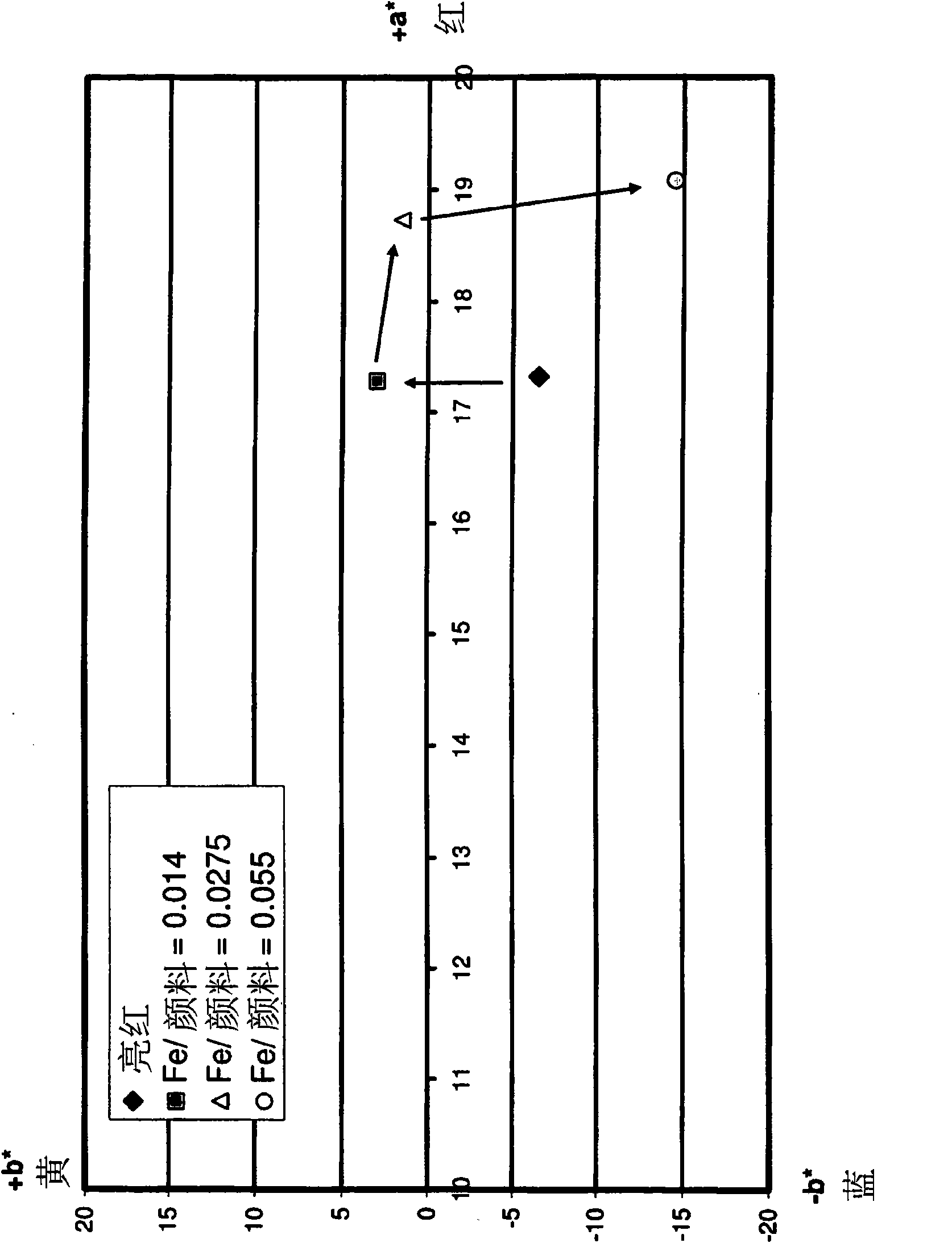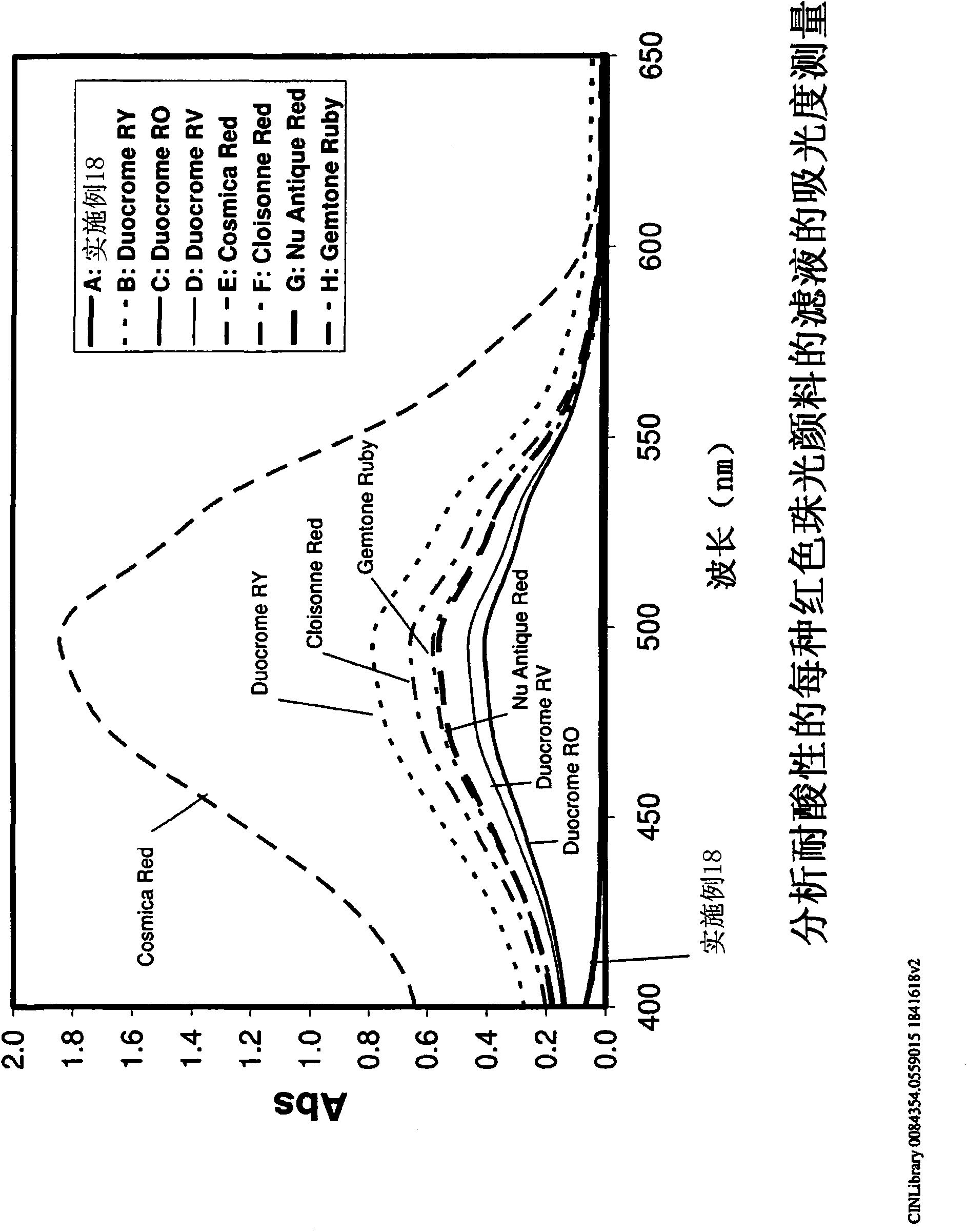Multi-colored lustrous pearlescent pigments
A pearlescent pigment, pigment technology, applied in the direction of pigment preparation, fibrous filler, drug combination, etc., can solve the problem of limited magnetic pigment and so on
- Summary
- Abstract
- Description
- Claims
- Application Information
AI Technical Summary
Problems solved by technology
Method used
Image
Examples
Embodiment 1
[0083] Example 1: FeCl for depositing readily reducible FeOOH layer 3 -Urea homogeneous hydrolysis method
[0084] • Add 0.1 M HCl solution (356.9 g) to a 500 ml cylindrical reaction vessel paddle (for gentle stirring and non-stick properties). The solution was stirred at 175 RPM. 7.1 g of 45%wt FeCl 3 Stock solution (Riedel 12322, 45% wt FeCl 3 , 55% water) was added dropwise to the reactor.
[0085] • Urea (16 g) was slowly added to the reactor with agitation.
[0086] • Add Sky Chemical Russet Pigment (20 g) to the reactor and stir for 5 minutes.
[0087] • The temperature was raised to 80°C at 2°C / min and maintained for 4 hours.
[0088] • The pigment is recovered by filtration and washed with distilled water.
Embodiment 2
[0089] Embodiment 2: the aqueous phase hydrogenation method of solid-solid catalysis
[0090] Step 1 - Wet Micronization of Catalyst
[0091] Platinum oxide powder (200mg, 10-50 micron grade, Aldrich 206032) in 100g PEG400 (i.e. 2mg PtO 2 / g fluid).
[0092] • The slurry was loaded into an Eiger-Mill apparatus with 0.5mm zirconia media and water cooling jacket. Power was set to maximum and run for 6 hours. The final slurry was dark green and did not settle for about 1 to 2 days.
[0093] • Particle size was checked with Dynamic Light Scattering (Horiba DLLS Particle Sizer) and OM (Optical Microscopy, Nikon) to ensure that no particles larger than 1 micron were left.
[0094] Step 2 - Hydrogenation
[0095] PEG 400 (100 g), FeOOH (20 g) coated red pearly pigment (i.e. SkyChemical Super Russet) and 3 g of micronized PtO from step 1 2 The slurry (2 mg catalyst / g fluid) was fed into a hydrogenation chamber of steel construction.
[0096] • The stirrer is lowered into the ...
Embodiment 3
[0106] Embodiment 3: Preparation of homogeneous platinum colloidal nanoparticle catalyst
[0107] • Polyvinylpyrrolidone (PVP) reducing agent solution: Anhydrous ethylene glycol (80 g) and K15 PVP (10 g, Fluka 81390 or ISP) were mixed with a Hauschild mixer at 3000 RPM until dissolved. This mixture was added to a 1 L 3.5" Teflon coated cylindrical reactor with a 2" PTFE coated 3-blade paddle and a nitrogen purge line.
[0108] Precursor solution: anhydrous ethylene glycol (80g) and H 2 PtCl 6 -6H 2 O salt (0.5 g, SAC3044) was added to a 4 oz jar with a magnetic stir bar and stirred until dissolved. The liquid was sonicated for 10 minutes to remove oxygen and then added to the PVP reducing agent solution.
[0109] • Mixing of precursor and reducing agent: Anhydrous ethylene glycol (80 g) was added to the reaction vessel followed by agitation at approximately 200 RPM to gently mix the precursor and reducing agent at room temperature. N 2 The purge line is lowered to just...
PUM
| Property | Measurement | Unit |
|---|---|---|
| magnetic susceptibility | aaaaa | aaaaa |
| thickness | aaaaa | aaaaa |
| magnetic susceptibility | aaaaa | aaaaa |
Abstract
Description
Claims
Application Information
 Login to View More
Login to View More - R&D
- Intellectual Property
- Life Sciences
- Materials
- Tech Scout
- Unparalleled Data Quality
- Higher Quality Content
- 60% Fewer Hallucinations
Browse by: Latest US Patents, China's latest patents, Technical Efficacy Thesaurus, Application Domain, Technology Topic, Popular Technical Reports.
© 2025 PatSnap. All rights reserved.Legal|Privacy policy|Modern Slavery Act Transparency Statement|Sitemap|About US| Contact US: help@patsnap.com



